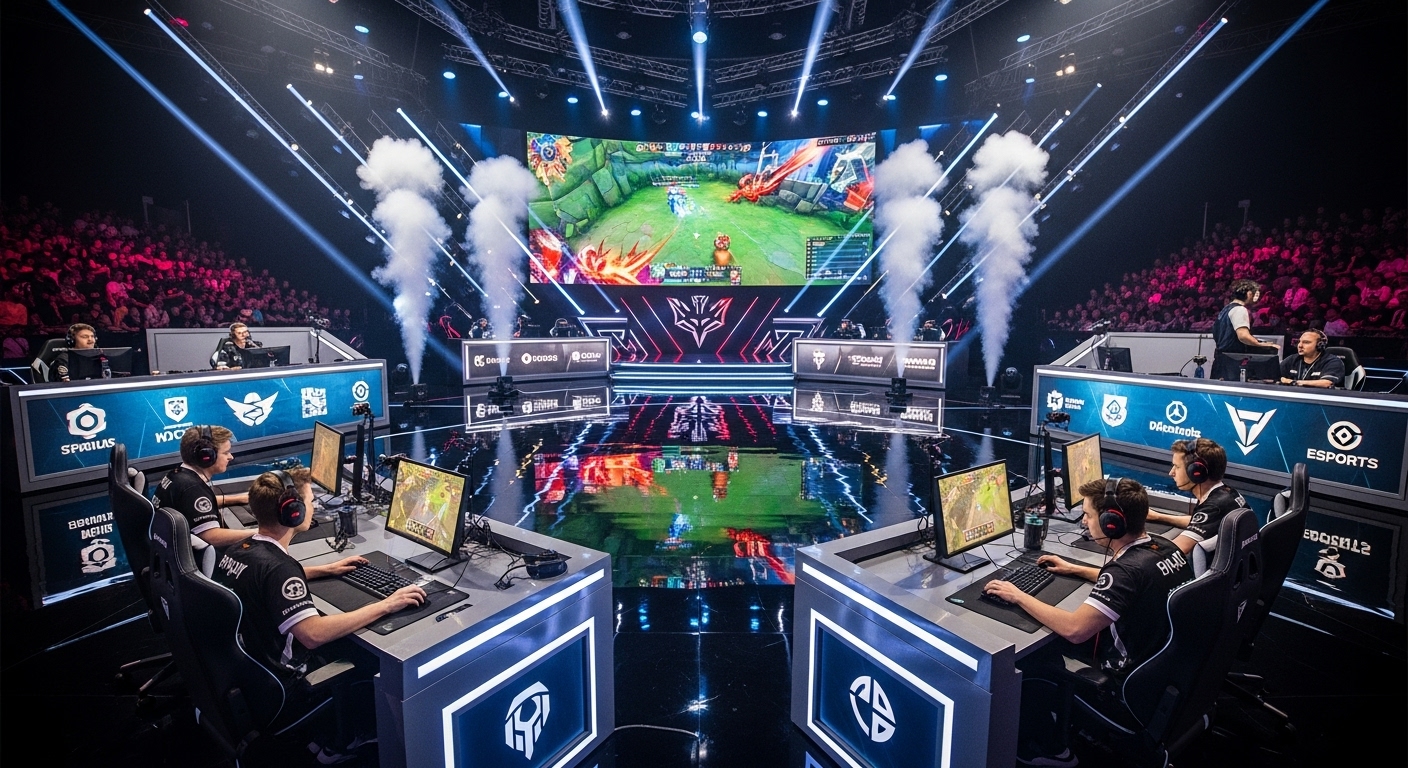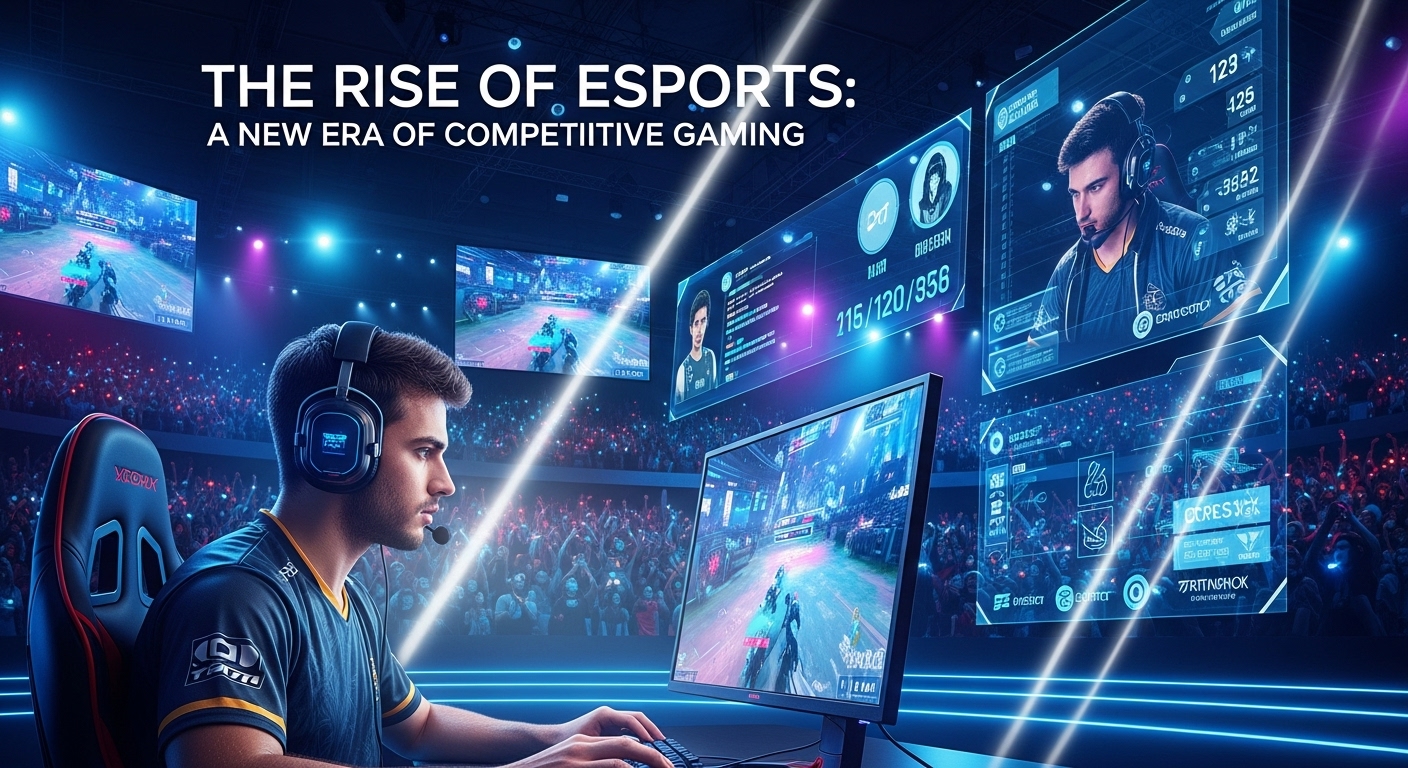In recent years, the world of competitive gaming has experienced an unparalleled surge in popularity, evolving from niche hobbyist competitions to a billion-dollar global industry. Esports, short for electronic sports, refers to organized, multiplayer video game competitions, particularly between professional players, individually or as teams. From online tournaments to massive arena events and global viewership numbers that rival traditional sports, esports has become a global phenomenon. But what has contributed to its meteoric rise, and where is it headed in the future? This blog delves deep into the history, evolution, and future of esports, highlighting the factors that have propelled it to its current state, the players and teams that have shaped it, and the unique culture surrounding competitive gaming.
The Birth of Competitive Gaming: From Arcade to Online
Esports has its roots in the early days of gaming, long before the massive industry it is today. In the 1970s and 1980s, video games were rapidly gaining traction as a form of entertainment. However, the concept of competitive gaming was still in its infancy. The first real indication of organized competition came in 1972 with the Space Invaders Championship, organized by Atari. The tournament, although small by today’s standards, attracted thousands of participants and marked the beginning of competitive gaming.
As gaming technology advanced and personal computers became more common, so did the ability to connect players and create multiplayer experiences. The 1990s saw the rise of online gaming, and with it, the first real multiplayer competitions. Games like Doom (1993) and Quake (1996) helped establish early online tournaments, allowing players from around the world to compete against each other. These games became the building blocks for what would later become a massive, global esports industry.
In the late 1990s and early 2000s, the first major online multiplayer games like StarCraft and Warcraft brought competitive gaming into the mainstream. The South Korean StarCraft scene, in particular, played a crucial role in the development of esports, with the country becoming a hotbed for professional gaming. The Korean government’s recognition of gaming as a legitimate form of entertainment, along with massive televised tournaments, helped to create a professional environment for esports that would later inspire other countries.
The Golden Age of Esports: 2000s and Early 2010s
The 2000s marked the true birth of modern esports as we know it today. While the infrastructure for esports was being established, games like League of Legends, Counter-Strike, Dota, and Warcraft III began to dominate the competitive scene. Online multiplayer games gained massive followings, and developers began to create titles specifically designed for competition.
One of the biggest milestones in esports came in 2003 with the formation of Major League Gaming (MLG), an organization that would play a critical role in the professionalization of esports in North America. MLG helped bring esports to the forefront by broadcasting events on television and streaming competitions online, allowing fans to watch professional gamers compete from the comfort of their own homes. At the same time, StarCraft tournaments in South Korea, such as the Proleague, set the standard for organized esports competitions with structured leagues, sponsorships, and massive prize pools.
The early 2010s saw esports truly take off, particularly with the release of League of Legends in 2009 by Riot Games. The game quickly became a global phenomenon, and by 2011, the League of Legends World Championship drew millions of viewers, a level of viewership that rivaled traditional sports broadcasts. The success of League of Legends ushered in an era where esports was no longer just a fringe hobby—it was becoming a mainstream form of entertainment.
This period also saw the rise of other major esports titles, such as Dota 2, Counter-Strike: Global Offensive, and Hearthstone. As these games gained popularity, so did their competitive scenes, with top-tier tournaments attracting professional teams, sponsors, and fans from all over the world. The prize pools for these events also grew exponentially, with the International Dota 2 Championship offering over $30 million in prizes in 2021, cementing esports’ status as a legitimate and lucrative industry.
Esports Goes Mainstream: Growth and Globalization
As the 2010s progressed, esports continued to expand, both in size and scope. The global nature of competitive gaming became evident, as major esports tournaments were broadcast in multiple languages and watched by millions across different continents. What was once a niche hobby enjoyed by a select group of gamers had transformed into a mainstream entertainment phenomenon, with major media outlets, including ESPN and Fox Sports, providing coverage of esports tournaments.
One of the driving forces behind this rapid expansion was the rise of streaming platforms, particularly Twitch. Launched in 2011, Twitch provided a dedicated space for gamers to broadcast their gameplay to a global audience, allowing viewers to interact with their favorite streamers and watch competitive gaming in real-time. Twitch quickly became the go-to platform for esports fans, and it helped propel the rise of esports stars who gained significant followings based on their skill and personality. By 2014, Amazon acquired Twitch for nearly $1 billion, signaling the platform’s growing importance in the entertainment ecosystem.
Esports teams and organizations also began to flourish during this period. In addition to the already established teams in League of Legends and Dota 2, franchises in games like Overwatch, Counter-Strike, and Fortnite began to emerge, with teams signing professional players and investing in training facilities, coaching staffs, and management teams. This professionalization of esports mirrored traditional sports in many ways, creating a structure for player development, sponsorship deals, and brand partnerships.
One of the most significant events during this period was the creation of the Overwatch League (OWL) in 2018. Blizzard Entertainment’s vision was to create a city-based, franchised esports league akin to traditional sports leagues like the NBA and NFL. The OWL featured teams from cities across the globe, including Los Angeles, New York, Paris, and London, and offered multi-million dollar contracts to players, highlighting the increasing financial stakes of competitive gaming.
Esports’ growth wasn’t limited to traditional gaming titles. Games like Fortnite, which debuted in 2017, sparked a new wave of esports interest. With its free-to-play battle royale mode, Fortnite not only became one of the most popular games in the world but also changed the nature of esports tournaments. Epic Games, the creator of Fortnite, made headlines with their Fortnite World Cup, offering a $30 million prize pool in 2019, further solidifying the legitimacy of esports in the eyes of both players and investors.
The Role of Technology and Streaming in Esports
One of the primary factors that has fueled the growth of esports is the evolution of technology, particularly in the realms of high-speed internet, gaming hardware, and live streaming platforms. In the past, esports events were limited by the technology available for broadcasting. Poor internet speeds, lower-quality streaming equipment, and lackluster hardware meant that only small audiences could access and enjoy esports events.
However, the advent of faster internet connections, 4K streaming technology, and the widespread availability of gaming consoles and high-performance PCs has transformed how esports is experienced. Streaming platforms like Twitch and YouTube have enabled esports content to reach millions of viewers, while social media platforms like Twitter, Facebook, and Instagram provide fans with constant updates, behind-the-scenes content, and direct interaction with players and teams.
On the hardware side, the development of more powerful gaming PCs, gaming laptops, and consoles has allowed for smoother, higher-quality gaming experiences for both players and spectators. Games are now being optimized for both performance and visual fidelity, enhancing the spectacle of esports events.
Esports in 2023 and Beyond: The Future of Competitive Gaming
As we move into the mid-2020s, esports continues to evolve at a rapid pace. The infrastructure that supports professional esports has expanded, with larger arenas, more sponsors, and even dedicated training facilities for players. The COVID-19 pandemic, while initially disrupting in-person competitions, accelerated the move towards online events and virtual competitions. This shift allowed esports to remain viable and relevant, even as traditional sports were put on hold during lockdowns.
The integration of esports into the educational system is another major development. Universities and colleges across the globe have started offering esports scholarships and building dedicated esports programs, signaling that competitive gaming is now recognized as a legitimate career path for young players. In fact, competitive gaming has become a key focus in the STEM (Science, Technology, Engineering, and Mathematics) fields, with esports offering students an entry point into technology, digital media, and event management.
Looking ahead, the potential for esports to continue growing is enormous. As new gaming technologies, such as virtual reality (VR) and augmented reality (AR), continue to develop, esports could soon incorporate immersive new formats that allow for even more exciting and engaging experiences. The emergence of blockchain technology and the rise of NFTs (non-fungible tokens) may also play a role in how esports monetizes content, rewards players, and engages with fans.
Furthermore, the global nature of esports means that it will continue to connect players from different parts of the world. With its broad appeal across various age groups, cultures, and backgrounds, esports will likely continue to bridge gaps in entertainment, education, and even diplomacy.
Conclusion: Esports as a Mainstream Entertainment Powerhouse
From humble beginnings in arcades and local LAN parties to a globally recognized entertainment industry, esports has come a long way. It has transformed from a niche interest into a billion-dollar phenomenon, captivating millions of fans, offering career opportunities for players, and creating new avenues for technology and entertainment. As technology continues to evolve and new games emerge, the future of esports seems limitless. Whether you’re a player, a fan, or simply a curious observer, one thing is clear: esports is here to stay.




